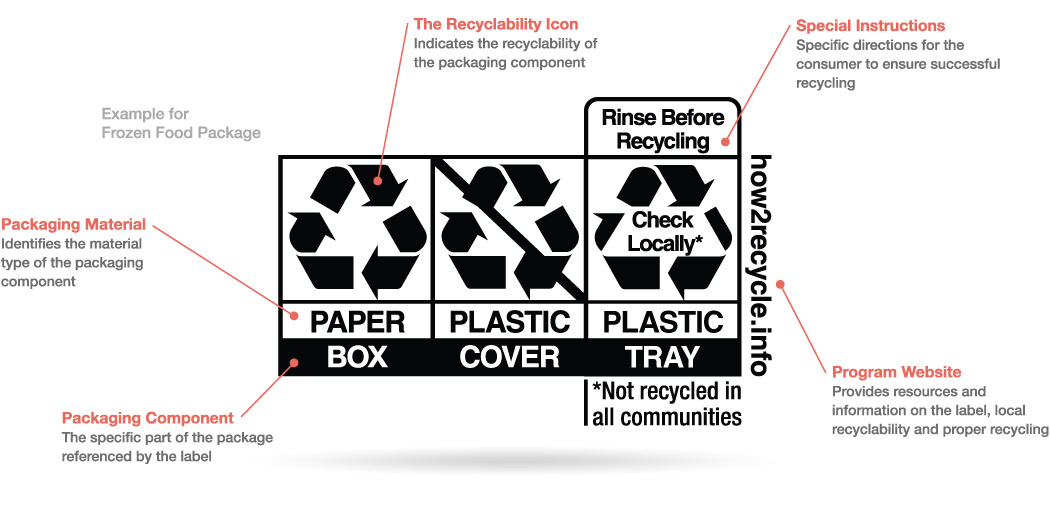More and more consumers are becoming interested in recycling but they’re not always sure if they can recycle a certain item or how to go about it, and they can’t always determine if the products they use are acceptable to their recycling program. Can the entire package be recycled or only parts? Does the label need to be removed before placing in the recycling bin? That’s where the How2Recycle label can help clear up the confusion. In honor of Earth Day (Aprill 22), we’ll explain how this standardized on-package labeling system works and different ways you can go greener with your custom labels.
What Is How2Recycle?
How2Recycle began in 2008 as a project of the Sustainable Packaging Coalition which later launched in early 2012. According to How2Recycle’s website, “Variation in recycling programs, unclear labeling, and inaccurate recyclability claims make proper recycling a challenge. The How2Recycle label was created to provide consistent and transparent on-package recycling information to the public.”
How2Recycle’s goals:
- Reduce confusion by creating a clear, well-understood, and nationally harmonized label that enables companies to convey to consumers how to recycle a package.
- Improve the reliability, completeness, and transparency of recyclability claims.
- Provide a labeling system that follows Federal Trade Commission Green Guides.
- Increase the availability and quality of recycled material.
How2Recycle claims that each label is based on the best availability of recycling data, as well as critical technical insights from Association of Plastic Recyclers, Recycled Paperboard Alliance, and other insightful industry experts. It’s the only recycling label system designed to comply with the Federal Trade Commission’s Guidelines for Environmental Marketing Claims and was the first recycling labeling system in the United States designed for consumers.
How2Recycle Label Format
Since products are packaged in different types of packaging, the information on their How2Recycle label will vary but they all follow the same format. There are five main label components:

Image source: How2Recycle
If you would like to get a How2Recycle label, you will need to become a member of its coalition. Its label system allows companies to track their entire packaging portfolio’s recyclability. Members also have access to How2Recycle’s platform where they can view recommendations to improve the recyclability of their packaging, analyze a breakdown of their packaging portfolio by recyclability category, and more.
Go Greener With Eco-Friendly Label Materials
Traditional pressure sensitive adhesives make it impossible to recycle labels but there are other ways to get labels that are better for the environment. For example, your labels can be one of the following:
- Recycled: The label stock contains materials recycled from the manufacturing process or post-consumer waste.
- Renewable: The label stock comes from resources which can be replenished as quickly as they’re used. Examples of renewable materials include corn, sugar cane, and bamboo.
- Recyclable: The label can safely go through the recycling process. (For a label to be able to go through the recycling process, it must have a “recycling compatible adhesive” – a specialty adhesive that is currently only available for paper-to-paper applications.)
- FSC Certified: The Forest Stewardship Council (FSC) is a non-profit organization that promotes responsible management of the world’s forests. According to its website, “FSC certification ensures that products come from responsibly managed forests that provide environmental, social and economic benefits.”
- PLA: Polyactic acid (PLA) is a biodegradable thermoplastic polymer made from renewable resources like corn starch or sugar cane. PLA film exhibits many properties that are equal or better than many petroleum-based plastics, making it suitable for a variety of applications.
We offer a variety of eco-friendly label materials in stock, however, we can order a specialty material if you need something else (please note that specialty materials may have minimum order requirements). Most of our customers who buy eco-friendly labels use one of the following products:
- FSC certified semi-gloss and matte papers: A lightweight paper with enhanced opacity and brightness that comes glossy or uncoated. It offers a balance of economy and performance, and can be applied to stainless steel, treated HDPE, polypropylene, recycled cardboard, and glass.
- FSC certified direct thermal paper: A smooth, bright white paper with a high sensitivity thermal coating. Direct thermal paper is often used by grocers to print food information for meat products or items to be frozen – but it’s also great for shipping, receipt, and barcode labels. This material features excellent resistance to 24-hour water immersion, blood, fats, oils, plasticizers, alcohol, solvents, and vinegar.
- FSC certified vellum paper: Also known as “estate label paper,” this paper is available in bright white or cream and it’s ideal for wine, high-end beverages, and gourmet foods due to its premium look and feel. The material has good initial tack and ultimate adhesion, which means that it sticks to the surface quickly and builds a strong bond. The adhesive is permanent, however, it can become removable in minimum 100° F water.
- Tree-free label stock: A white paper-like stock made from bamboo pulp, sugar cane, and cotton linters. Tree-free label stock provides a smooth print surface and is ideal for specialty food and wine labels.
- PLA white film: A compostable, white film that is made from an annually renewable plant source rather than petroleum and other fossil resources. PLA film is water and scratch resistant like other films, making it suitable for a variety of markets like food, beverage, beauty, health, and more.
To get started on your eco-friendly labels, please call us at 1-800-475-2235 or email [email protected]. If you’re not sure which material to use or you’re looking for another label material type, we would be happy to help you find the right labeling solution.


